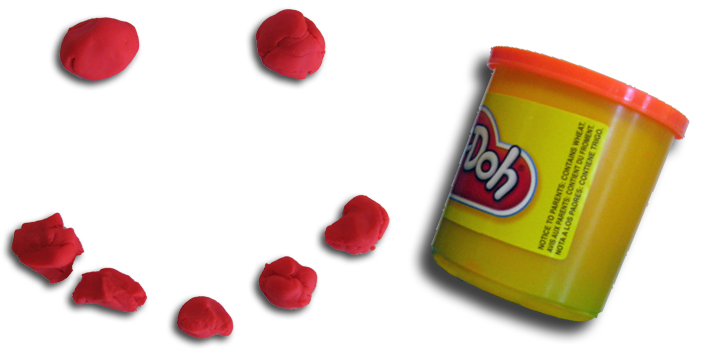
MOLDED FOR WRITING
The No "Doh!" Lesson for APA & Grammar

Do you remember as a child taking play dough (or clay) in your hands and molding it into a masterpiece? Do you remember the feeling of pride that you felt as you looked at your finished masterpiece? In graduate school, you have the opportunity to use words to create masterpieces in which you can also feel a sense of pride and experience success. However, before creating a successful masterpiece, you need to understand how to construct your masterpiece in style (APA style, that is). The purpose of this lesson is to assist you in understanding how to write a paper in APA style.
When you are finished with this lesson, you should:
(Note the corresponding lesson to the "APA style" is the "APA Referencing and Citing" lesson. By completing this corresponding lesson, you should; (a) Know how to cite works in APA style and (b) Know how to write an APA style "Reference" page (Not a "Work cited" or "Bibliography" page -- these are not APA). Make sure you complete both lessons).
Learning this knowledge and these skills will assist you in:
Let's get started!
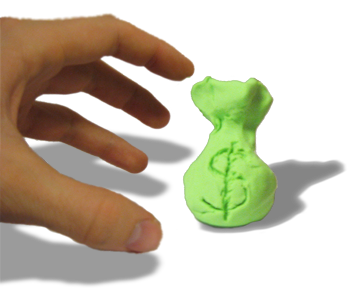
Imagine for a moment that you wrote a paper for one of the university courses in which you are now enrolled and posted it on the web for your friends and families to read. Five years in the future, you read a book that is on the best seller list or is a popular text book adopted for courses. The book makes thousands, or even millions, of dollars. When you read chapter 3, you find that it is almost an exact replication of the paper that you posted to the Internet. Your work was not cited as the original source. How do you feel when you read it? What would you do about it? What would you do about it if we had standards for citing or rules governing writing?
Plagiarism is one of the many reasons that we have editorial style guides for writing. Can you think of other reasons?
Editorial style consists of rules or guidelines that a publisher observes to ensure clear and consistent presentation of written material. You will learn the uniform uses of elements in APA such as:
There are different editorial styles adopted to present written material. They include:
APA format is the style most often used for writing in the social and behavioral sciences. APA format is required for this course and the editorial style of choice for most publications in the disciplines of psychology, human services, and counseling. Thus, it is important for you to learn APA's style rules and guidelines.
APA's style rules and guidelines are contained in a manual book entitled the Publication Manual of the American Psychological Association (6th Edition), a publication of the American Psychological Association in Washington D.C. Learning to use the style form well demands having a copy of the manual. The manual serves as a principle reference guide (you need to obtain a copy of this manual), always at the researcher's and writer's elbow. It will be the reference used for this lesson, and page numbers and sections of the manual are cited throughout this lesson.
This lesson will not be exhaustive and in no way replaces the manual; however, it is intended to introduce you to, and for some of you provide a review of, the APA's style rules and guidelines to assist you in sculpting your writing masterpiece.

|
MIND MOLDER |
|
When researchers talk about APA style, they may be referring to APA's system of citations in text and reference format. If you are unsure, you should clarify with your instructors or editors how they define "APA style." |

As you prepare to sculpt your writing masterpiece in APA style, take time to configure the settings on your word-processing software program, Microsoft Word, bundled in Microsoft Office. Watch the tutorial to learn how to configure your word processor (courtesy of Regent University's Student Services). This tutorial requires the Adobe Shockwave Player. The Shockwave Player is free, easy to get, and available to everyone on the Web. Download the latest version of the Shockwave Player if you do not already have it.
|
Tip: Throughout this learning unit, you will find markings such as "(5.04)." Each of these marks the specific location of a given topic in the APA manual. |
Whether you watch the tutorial linked above or not, you may find it helpful to read the steps below. Take time now to configure your word processor.
APA Survival Settings:
|
TIP: Start on the second page first and create the right-justified Header the way you want it to show on all subsequent pages. Make sure you check the "Different first page" box. Then go to the title page and create the same header with tabs separating the running head (p. 230) so that the running head looks left-justified. They should both be on the same line. See example later in this lesson. |
Set your Microsoft Word spelling and grammar toolbar settings to improve your writing. Below are the ones I find most useful for the APA writing style. Hope you find this helpful too. Spelling errors will have faint red underlines; grammar errors will have faint green underlines.
To access the settings below in Microsoft Word 2003, navigate to: Tools > Options > Spelling & Grammar.
To access the settings below in Word 2007, click the Windows "pearl" button on the top left corner. Click on "Word Options" at the bottom, then select the "Proofing" tab on the left.
To access the settings below in Word 2010, click the file button on the top left corner of Word. Click on "Options" at the bottom of that menu, then select the "Proofing" tab on the left. The following directions are pertinant to Word 2010 but can be adapted to any previous version of Microsoft Word.

Once you are in the menu, apply the settings above.
On this same settings page, navigate to "Writing Style: Grammar & Style" and click on "Settings." Apply the following in that menu:
Require:

Grammar:
Make sure every box on this page is checked.
![]() One additional setting that you may find helpful is the "Reveal Formatting" toggle. This button is the character on your Word toolbar that looks like a backwards "P". (The symbol is presented on the right.) This "Reveal Formatting" toggle can help you catch what is normally hidden to you in Microsoft Word.
One additional setting that you may find helpful is the "Reveal Formatting" toggle. This button is the character on your Word toolbar that looks like a backwards "P". (The symbol is presented on the right.) This "Reveal Formatting" toggle can help you catch what is normally hidden to you in Microsoft Word.
Now that we have some of the Word software settings out of the way, let's get started with a review of some basic grammar rules.
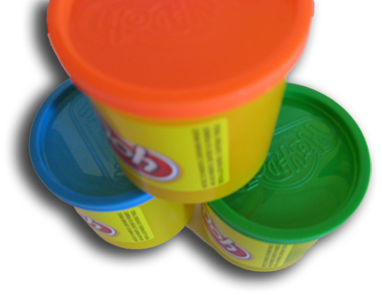
Now that you have configured your word processor, you are ready to begin creating a structure for you masterpiece.
APA-style manuscripts require the following sections in this order (see pp. 228-236; see example paper on pp.40-59):
|
Refer to p.23 for the title, author, and institutional affiliation that are center aligned on the page.
For example: Attachment Theory and Adult Religiosity Literature Review Amanda J. Rockinson-Szapkiw Regent University
|
|
The running head for publication is an abbreviation of your title that will be used as a running head [page header] for the published article. The running head is typed on the same line as the page header, flush left, in UPPERCASE, following the words "Running head:". The running head should not exceed 50 characters, including punctuation, spacing, and the 14 characters of "Running head." In large manuscripts (or dissertations) the running head appears on every page.
For example: (mouse over the words) Running head: ATTACHMENT THEORY
|
|
The page header and page number are also included on the title page and every page of the manuscript. The page header is the first two or three words of the title in the upper right-hand corner . . . five spaces to the left of the page number. It is located one half of an inch from the top of the page, aligned right. Note: There are 5 spaces between the words and the page number. Always ask your instructors if they have a preference for the words you use for the header, as some prefer that you use your name. Put your cursor to the left of the first letter of the first word (or your name), type your running head, and then insert enough tabs for the running head alone to align left.
For example: Running head: ATTACHMENT THEORY [tab] [tab] [tab] [tab] [tab] tab] [tab] [tab] [tab] [tab] tab] [tab] [tab] [tab] [tab] [tab] [tab] Your Name 1 |
|
The abstract is a brief summary of the paper that is 120 words or less. On the abstract page, the word "Abstract" is centered at the top of the page. The text of the abstract is double spaced and left aligned. Some short college papers may not merit an abstract. Always ask your instructor if you should include an abstract (2.04 pp. 25-27).
For example: Abstract Two contrasting hypothesis have been proposed about the relationship between parent-child attachment and adult religiosity. Evidence for both hypotheses has been found. The compensation hypothesis proposes that God may serve as a substitute attachment figure for individuals who experienced insecure attachment patterns (Kirkpatrick, 1998; Kirkpatrick & Shaver, 1990). The correspondence hypothesis proposes that God is attached to in a similar fashion as an individual attaches to their caregiver (Brokaw & Edward, 1994; Hall, Brokaw, Edwards, & Pike, 1998). Literature supporting each of these hypotheses is reviewed. Methodology concerns and implications for further research are discussed. |
|
The text should begin on a new page. Do not give an introduction heading. On the first page of text, the title of the paper is centered at the top of the page. Then, the text and headers are typed, double spaced in the preferred font of Times New Roman in 12 point size. All text is left aligned, and paragraph indentions are five spaces. Remember that there is only one space after each of the periods.
The section headers guide your reader and provide an outline for your manuscript. For short articles and most of your college papers, only one to two levels of headings are needed (3.02, 3.03, pp. 62-63). |
|
Citations in the text of the manuscript are enclosed in parentheses and include the author's last name(s), publication year.
For example:
(Kirkpatrick, 1998)
|
|
The in-text citations are listed in the reference section. The reference section follows the text of your manuscript. The word "References" is centered at the top of the page. Citations are alphabetized, double spaced, and hanging indent formatted. Do not manually with enters or tabs align your references. Use the ruler bar and the word processor to set the indents for second and subsequent lines of each reference. You may need to check View > Ruler
For example: References
Kirkpatrick, L. A. (1998). God as a substitute attachment figure: A longitudinal study of adult attachment style and religious change in college students. Personality and Social Psychology Bulletin, 24, 961-973.
|
Some manuscripts also include additional material such as tables, figures, and appendices. These are located after the reference page.
Before you go on, test your knowledge about the components and organization of an APA –style manuscript.




Now you understand the primary components and structure of an APA style manuscript, you are well on your way to creating a successful writing masterpiece. There are, however, a few more items that you need to consider before you begin writing.
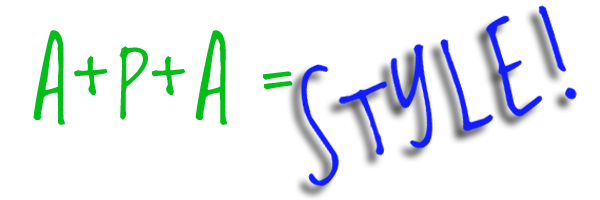
Have you ever worked really hard on a paper and had it returned to you with a poor grade because of poor grammar or poor APA style application? Over the years, faculty has identified common general English language and grammar writing errors that often lead to poor grades. They have also identified common APA writing and editorial style errors that have resulted in poor grades. We will discuss some of these errors in an effort to help you avoid them in your writing. Thus, helping you avoid poor grades and, ultimately, professional embarrassment. Let's begin by looking at five common errors (also known as your instructors' pet peeves) in academic writing: (a) sentence structure and variety errors, (b) paragraph structure errors, (c) punctuation errors, (d) grammar errors, and (e) APA writing and editorial style errors.
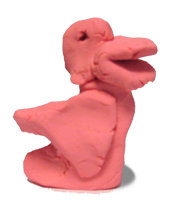
"Don't touch me!"
The errors listed here are your instructor's primary pet peeves; however, the list is not exhaustive.
The first common error that results in poor writing is poor sentence structure and variety.
Before we can understand how to avoid poor sentence structure, we need to understand good sentence structure. A basic simple sentence has a subject and a verb that expresses a complete thought (Does this sound familiar? It is probably a concept you learned in elementary school and reviewed in you Introductory English class in college).
Simple Sentence = Subject + Verb.
Sentence structure errors occur when a sentence does not have a subject or a verb or when a sentence contains too many without proper punctuation. These two sentence structure errors are called fragments and run-on sentences, respectively.
FragmentsFragments are incomplete sentences that do not have a subject or a verb.
Examples of a fragment: • A handsome man with dimples. • Susan crawled across the floor for the first time. Impressing her parents. |
Run-on SentenceA run-on sentence is a sentence which contains two or more independent clauses 'pushed together' without a 'break in punctuation.'
Example of a run-on: • Sarah is a good natured young lady she loves to smile and to help people.
|
How could you correct the two example fragments and make them complete sentences?
A handsome man with dimples ______.

Impressing her parents Susan crawled across the floor for the first time.

How could you correct the one example of a run-on sentence and make it a complete sentence?


To avoid poor writing, avoid poor sentence structure. Always ensure that your sentences have a subject and verb.
Poor sentence variety is another common error that results in poor writing. Some individuals use too many complex sentences that result in reader confusion. Other individuals use too many simple sentences; this renders choppy writing. For example:
Jane is a girl. Jane is happy. She likes to play with dolls. Jane also likes to play with toy trucks. She does not like to stop playing. She throws temper tantrums.
Good writers use a combination of both complex and simple sentences.
The use of coordination and subordination can make your writings interesting to your readers and can increase clarity and flow of thought.
CoordinationCoordination combines simple sentences using a coordinating conjunction and a comma or a semicolon and a conjunctive adverb. Each sentence is given equal attention.
Coordination Examples
Example 1: Sentence 1 [comma] (coordinating conjunction) Sentence 2.
Coordinating conjunctions: and, but, or, yet, etc.
Jane likes to play with dolls and trucks, but she does not like to stop playing.
Example 2: Sentence 1 [semicolon] (conjunctive adverb) [comma] Sentence 2.
Conjunctive adverbs: however, therefore, moreover, consequently, etc.
Jane has a difficult time transitioning between activities; consequently, she needs to be given a five minute warning before she transitions.
Punctuation Tip: The first sentence that ends is followed by a semicolon, a conjunctive adverb, a comma, and then the second sentence.
Example 3: Sentence 1 [semicolon] Sentence 2.
Punctuation Tip: The sentences must be related to use a semicolon.
Jane likes to play with dolls and trucks; she does not like to stop playing.
|
SubordinationSubordination combines simple sentences and makes one dependent upon the other.
Subordination Examples
Example 1: Sentence 1 (subordinating word) Sentence 2.
Subordinate words: Because, since, when, although, if, etc.
Jane will throw a tantrum if you ask her to stop playing with her toys.
Punctuation Tip: No comma is used when the subordinate word is between two sentences.
Example 2: (Subordinating word) Sentence 1 [comma] Sentence 2.
When you ask Jane to stop playing with her toys, she will throw a tantrum.
Punctuation Tip: A comma separates the dependent sentence (first sentence) from the independent one (second sentence).
|
Directions: Read the paragraph.
Jane is a seven year old young lady. She has many positive attributes___ however, these attributes are often overshadowed by her many behavioral problems. Jane is caring, loving, and helpful___ she enjoys helping her mother clean and her father work in the yard. When Jane is in a good mood___ she plays and shares with others. When Jane is not in a good mood___ she does not get along with others. Jane will hit her friends___ when they try to play with her toys. Jane often throws tantrums and is non compliant toward adults.
Directions: Now that you have read the paragraph, use the coordination and subordination rules to fill in the correct punctuation for each of the sentences. If no punctuation is needed, type the word "none" as your answer.





|
MIND MOLDER |
|
Be Precise: The use of coordination and subordination can make your writings interesting and increase clarity and flow of thought. However, the use of too many transitional words, which are used in coordination and subordination, can also result in less precise writing. APA style requires precision in writing. Use transitional words; however, make sure that you limit their use. Read pp. 65-70 of the Publication Manual, 3.05 - 3.11Writing Style. |
Download the sentence variety chart to assist you in your writing.

The second common error that results in poor writing is poor paragraph structure. To ensure that you avoid poor paragraph structure, you need to understand good paragraph structure.
Prior Knowledge Activity
Directions: Let's see what you remember from your basic grammar classes. Read the sentence below, and see if you know the missing words. Mouse over the blanks to reveal the answers.
Every paragraph needs one ________ sentence and three to five ________ sentences.
The Topic SentenceThe topic sentence (also known as a thesis sentence) introduces the main points (usually one to three) for the paragraph. The topic sentence is usually the first sentence in the paragraph, but it does not have to be the first sentence. |
The Supporting SentencesThe supporting sentences support the points outlined in the topic sentence, usually with examples, logic, explanations, quotations, and ideas. |
Directions: Read the paragraph about Jane. Use the paragraph to answer the questions that follow.
Jane is a seven year old young lady. She has a mom who is forty eight. She has many positive attributes; however, these attributes are often overshadowed by her many behavioral problems. Jane is caring, loving, and helpful; she enjoys helping her mother clean and her father work in the yard. When Jane is in a good mood, she plays and shares with others. When Jane is not in a good mood, she does not get along with others. Jane will hit her friends when they try to play with her toys. Jane often throws tantrums and is non-compliant toward adults.



|
MIND MOLDER |
|
Remember that the first (one to three) paragraph of your paper is the thesis paragraph that outlines the purpose of the paragraph, provides an introduction to the topic, and delineates the contents of the paper. Each of your preceding paragraphs should support the thesis of the paper and build upon the prior paragraphs. Use transitional sentences between paragraphs to summarize the preceding paragraph and introduce the topic of the next paragraph. Transitional sentences between paragraphs increase flow of thought and clarity. Finally, the final paragraph of your paper should summarize the contents of the paper and provide a conclusion. See p. 68 on length of paragraphs. |
Download the APA paper to see an example of these two types of paragraphs and transitional sentences.
Download the Outline an Academic Paragraph worksheet to assist you in your writing.

The third common error that results in poor writing is poor punctuation usage. Punctuation is important because it tells the reader "where to pause, stop, or take a detour" (4.01 - 4.11). Punctuation is a component of the APA editorial style (Note: This is important to recognize because some of the rules differ from Chicago and MLA style). This lesson will highlight some of the most common punctuation errors; however, read pp. 87-96, 172 of the Publication Manual to ensure that you understand all of the punctuation rules.
Here we will consider: (a) commas, (b) semicolons, (c) colons, (d) quotation marks, and (e) parentheses. Please make sure you read about dashes, brackets, slashes, and additional rules for each mentioned punctuation not covered in this lesson.
Comma ErrorsCommas are very useful, but commas are often misused punctuations.
Three common comma misuses are:
Comma splicesLike a run-on sentence, comma splices occur when only a comma is used to separate two or more independent clauses. For example, "Jack is good natured, he loves to watch people and smile at them" is a comma splice. You would correct this in the same manner discussed for run-ons: (a) two separate sentences, (b) semi-colon, or (c) comma and coordinating conjunction. Missing commasOften individuals forget to use commas, for instance, a comma always goes after the penultimate word in any list of more than than two items e.g., "The carpenter picked up his hammer, nails, bucket,and tape." Listed below are other common instances where people forget to use commas.
Directions: For each item example, complete the Check Your Understanding Activity. In each example, mouse over the words that you think need a comma after them. Between elements and before the conjunction in items in a series.
To set off subordinate clauses. (A subordinate clause provides additional information about one element in your sentence. In most cases, these clauses should be set off from the rest of your sentence with a pair of commas.)
To set off the year in exact dates.
To set off the year in a parenthetical citation.
Nonessential additions of commas. Often individuals use commas in places where they are not necessary. They typically put commas where they would pause or take a breath when speaking the sentence. Listed below are some common instances.
Between the two parts of a compound predicate.
To separate components of measurements.
|

Semicolon ErrorsOften individuals are unsure when to use semicolons. Semicolons should be used in the following two instances:
To separate items in a series that contain commas.
To separate two independent clauses that are NOT joined using a conjunction.
|

Colon ErrorsColons are another type of punctuation that individuals are often unsure when to use. Colons should be used in the following instances:
Between an introductory clause that is a complete sentence and an idea that extends or illustrates the introductory clause (Note: if the idea following the introductory closure is a complete sentence it begins with a capital letter).
In references between the place of publication and the publisher.
In ratios and proportions.
|

Quotation ErrorsWhen using APA style for writing, individuals often get confused about when to use quotations and when to use italics. In this lesson, we will review when to use quotations. Read section 6.15, p.176 of the Publication Manual to identify when to use italics instead of quotations and pp. 170 - 173 (6.03 - 6.09) to identify how to use quotations.
When to use quotations: The first time a word or phrase that is ironic, slang, invented, or coined is used (Note: only use quotations the first time it is mentioned; thereafter, do not use quotations around the word or phrase).
To note a quote or the reproduction of material verbatim that is fewer than 40 words.
Tip: Quotations of forty or more words should be displayed as block quotes. To read more about block quotes see section 6.03 (pp. 170 - 171) of the Publication Manual.
To note a title for an article or a chapter in a periodical or book in text (Note: NOT in the reference list).
Tip: The ampersand ("&") belongs only in parenthetical material such as in-text citations or in the references. Use "and" in the text of the paper.
|

Parentheses ErrorsParentheses are the last type of punctuation covered in this lesson. Parentheses are used in the following situations: To introduce abbreviations for the first time.
To set off the letters used in a series of items within a sentence.
Tip: Enumerating items in a series that are lengthy or complex assists with clarity for the reader. Identify items by lowercase letters with parentheses when items are within a paragraph or sentence; identify items in a series using Arabic numbers followed by a period (no parentheses) when items are separate paragraphs. To read more about items in a series see section 4.09 - 4.10 (pp. 93 - 94) of the Publication Manual.
To set off structurally independent elements.
To set off citations within the text.
Tip: Do not use back-to-back parentheses. Use one set of parentheses and a semicolon to separate the two pieces of information.
|
Check Your Understanding ActivityYou now have covered the Poor Punctuation Usage section that discussed semicolons, colons, quotes, and parentheses. The following sorting activity will give you an opportunity to test your learning.
|
Punctuation Tip: Use only one (1) space after a period; the only exception is for draft manuscripts (p. 88).
Now that we have reviewed punctuation errors that are commonly made, we will consider grammar usage (Note: This is an example of a transitional sentence).
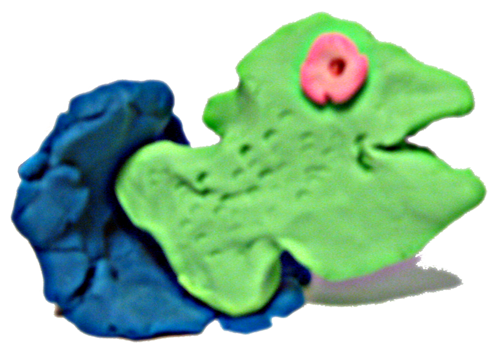
The fourth common error that results in poor writing is poor grammar usage. "Incorrect grammar and careless construction of sentences distract the reader, introduce ambiguity, and generally obstruct communication" (APA, 2009, pp. 77-84). Too often important messages are miscommunicated or never communicated because of poor grammar. This lesson will highlight some of the most common grammar errors (also known as this instructor's primary pet peeves). To improve your writing, you may also want to review material from Basic English grammar classes that you have taken.
In this lesson, we will consider: (a) verbs, (b) dangling modifiers, and (c) parallel construction. In the Publication Manual, please make sure that you read about pronouns (e.g., especially determine when to use which vs. that), linguistic devices (e.g. Avoid alliterations, poetic expressions, and clichés. Use metaphors sparingly), and subject-verb agreement (A verb needs to agree in number with the subject: plural noun + plural verb and singular noun + singular verb) not covered in this lesson. Hint: These are also pet peeves of your instructors.
Resources:
Check out the resources at Purdue's Online Writing Lab's (OWL) on Subject-Verb Agreement and Pronouns to further assist you in your writing. The Subject- Verb Agreement is helpful. It can be accessed through the following link: http://owl.english.purdue.edu/handouts/esl/eslsubverb.html.
Regent University Writing Center has a good handout on the use of which vs. that. You can download it from here

Prior Knowledge Activity
Directions:
Before we begin discussing grammar rules, let's see what you remember. Answer True or False.





Verb Usage ErrorsThe Publication Manual has specific directions about using verbs (see section 3.06, pp. 65-66 and section 3.18, pp. 77-78). Although there are multiple rules, students most often violate two of these rules by using passive voice and overusing the word would. The rules are:
Use Active Voice
The APA manual defines verbs as "vigorous, direct communicators" and states that active rather than passive verbs should be used in writing. In a sentence written in active voice, the subject or noun does the action.
Example of a passive verb: The direct observation was conducted in the classroom setting. Example of an active verb: The experimenter conducted a direct observation in the classroom setting. Check Your Understanding Activity
Resources: Check out Purdue's Online Writing Lab's (OWL) Active verb link. This link provides a list of all of the verb tenses in active and passive voice. Also download the OWL guide to active and passive verbs to assist you further in your writing of sentences in active voice.
Use the word would sparingly
The word would is used correctly to express a condition or action that is completed habitually or that is conditional. The word would is used incorrectly when it is used to hedge.
Example of using the word "would" for a condition or action that is completed habitually: Jane would throw a tantrum when she was asked to comply with a command immediately. Jane would not throw a tantrum if she was given a five-minute warning before she was asked to comply with the command.
Example of using the word "would" for a condition or action that is conditional: Jane's parents would give her a five-minute warning if time allowed.
Example of using the word "would" to hedge: It would appear that Jane needs a five-minute warning.
Tip: When discussing an action or condition that occurred in the past, students sometimes forget the rules about when to use past tense and when to use present perfect tense.
|

Misplaced and Dangling Modifier ErrorsA modifier describes, clarifies, or gives more detail about a word.
A misplaced modifier is a modifying word or phrase that is attached to a word different from the one the writer intended. Thus, the sentence is unclear or ambiguous. Misplaced modifiers are easily eliminated by placing modifying words and phrases as closely as possible to the word that they modify.
Example of a misplaced modifier: I observed the counseling session watching through the one-way mirror. (Presumably, I mean that I was watching through the one-way mirror, but the placement of "through the one-way mirror" makes it sound as though the counseling session was watching through the one way mirror.) Example of a correctly placed modifier: I, watching through the one way mirror, observed the counseling session.
Dangling modifiers "have no referent in the sentence." Dangling modifiers are often a result of writing in passive voice; they can be avoided by writing in active voice.
Example of a dangling modifier: After reading the psychological report, the diagnosis was unclear. (Diagnosis is the subject of the main clause; thus, the sentence currently implies that the diagnosis read the psychological report. That is, "After reading the psychological report" modifies "diagnosis.") Example of correctly placed modifier:After reading the psychological report, I found the diagnosis unclear. Check Your Understanding ActivityDirections: Decide if these sentences have a dangling modifier, misplaced modifier, or a correctly placed modifier.
Tip: Limiting modifiers (e.g. only, almost, just, merely, simply, even) are other types of modifiers that students often misuse. Limiting modifiers can confuse readers. Consider, for example, the following two sentences: (a) People who use drugs frequently suffer health problems and develop addictions and (b) People who frequently use drugs suffer health problems and develop addictions. What is actuallly meant? Which is clearer? Read more about the use of modifiers in section 3.21 pp. 81-83 of the Publication Manual.
|

Parallel Construction ErrorsParallel construction, in the context of grammar, refers to using the same pattern of words to demonstrate that the thoughts or ideas are of equal importance. Parallel construction includes using the same form whether you are writing a list of items, writing a list of verbs, or writing a sentence with clauses. When writing a sentence with lists, the APA manual states that you should, "Make certain that all elements of the parallelism are present before and after the coordinating conjunction" (Section 3.23 pp. 84-86). When writing a sentence with clauses, you should ensure that you do not change patterns or voice (e.g., active to passive or vice versa).
Example of a sentence that is not parallel: Jane likes playing, swimming, and to ride her bike. Example of a sentence that is parallel: Jane likes playing, swimming, and riding her bike. Or Jane likes to play, to swim, and to ride her bike.
Example of a sentence that is not parallel: The psychologist told Jane's parents that she should get plenty of sleep, that she should eat healthily, and to get exercise. Example of a sentence that is parallel: The psychologist told Jane's parents that she should get plenty of sleep, that she should eat healthily, and that she should get exercise. Check Your Understanding ActivityDirections: Decide if each sentence in the activities below has Parallel construction or does not have Parallel construction. Select True if it has Parallel construction and select False if it does not have Parallel construction.
Now that we have reviewed frequent sentence, paragraph, punctuation, and grammar errors, we will turn our attention more specifically to APA writing and editorial style. We will begin by looking at the top seven APA style errors that students make.
|

The fifth common error that results in unclear writing and poor grades in graduate school is poor understanding of the APA writing and editorial style (Note: Here Editorial Style refers to all editorial elements except punctuation, which has already been discussed). Here we will consider the top seven APA writing and editorial style errors noted by your instructor.
Test yourself first.
Directions:In each multiple choice question, choose the correct format for APA style.







Now venture on to the next page to see the full list of correct APA styles from Error (Pet Peeve) #5 along with additional examples.

The use of jargon (Section 3.09, p. 68).Jargon is the use of technical language or familiar terms. Using jargon may assist you in conveying information efficiently to those familiar with your field; readers unfamiliar with your field and its jargon may find jargon impolite and confusing. Always take your audience into consideration when determining when to use jargon in your writing. Avoid jargon when unnecessary. The example give in the APA Publication Manual is: Incorrect: monetarily felt sacristy Correct: poverty
|
The use of wordiness (Section 3.08, p. 67).Wordiness is the use of uneconomical and irrelevant words that can irritate the reader and can impede the reader's understanding.
Example: Incorrect: There were several researchers who found similar results. Correct: Several researchers found similar results.
Incorrect: The subjects that are considered most important by students are those that have been shown to be useful to them after graduation. Correct: Students consider subjects useful after graduation to be the most important.
|
The use of redundancy (Section 3.08, p. 67).Redundancy refers to the unnecessary repetition of words or ideas.
Example: Incorrect: It is very unusual to find someone who has never told a deliberate lie on purpose. (Note: Deliberate and on purpose mean the same thing). Correct: It is very unusual to find someone who has never told a deliberate lie.
The APA manual provides the following examples (words in bold and underlined are redundant and should be omitted):
|
The use of incorrect or undesirable attributions: Anthropomorphisms (Section 3.09, p. 69).Anthropomorphisms are the attribution of human motivation, characteristics, or behavior to inanimate objects, animals, or natural phenomena. The use of anthropomorphisms results in lack of precision and clarity in writing and should be avoided.
Example: Incorrect: The program was convinced of the communication policy. (Can a program adopt something?) Correct: The staff of the program was convinced of the communication policy.
|
The use of incorrect or undesirable attributions: Third Person (Section 3.09, p. 69).In APA, always write your paper in third person except for inappropriately attributing action in an effort to be objective. Writing 'the experimenter instructed the participants' when 'the experimenter' refers to yourself is ambiguous and may give the impression that you did not take part in your own study. Instead, use a personal pronoun: 'We instructed the participants.'
Example: Incorrect: The researchers concluded Correct: We concluded
|
The incorrect use of numbers. (Section 4.31 - 4.38, pp. 111 - 114)The general rule is to use numerals to express numbers 10 and above and words to express below 10. That means spell out numbers between zero and ten; use figures for all other numbers.There are some exceptions and special usages so read the section carefully. Incorrect: 6 inches Correct: six inches
Use figures for numbers less than 10 when grouped with numbers above 10 Incorrect: three out of 15 students. Correct: 3 out of 15 students.
Spell out numbers at the beginning of the sentence Incorrect: 135 subjects participated in the study. Correct: One hundred thirty-five subjects participated in the study.
|
The use of bias language. (Section 3.12 - 3.17, pp. 70 - 77)"Gender refers to role not biological sex and is cultural. Avoid ambiguity in sex identity gender role by choosing, nouns, pronouns, and adjectives that specifically describe your participants" (p.73). Alternatives to the generic "he" including rephrasing are located at GUIDELINES FOR UNBIASED LANGUAGE and General Guidelines for Reducing Bias Example: Incorrect: Selfishness is a common problem for mankind. Correct: Selfishness is a common problem for humankind.
Incorrect: Three hundred Orientals participated. Correct: Three hundred Asians participated.
|
You are almost finished with this learning unit! Continue on to the next page and reflect upon what you have learned!
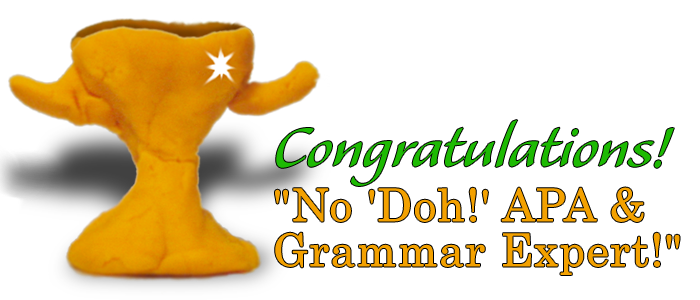
You now have the knowledge that you need for how to construct your masterpiece in style (APA style, that is).
Now that you are finished with this lesson, you should:
Happy Writing!